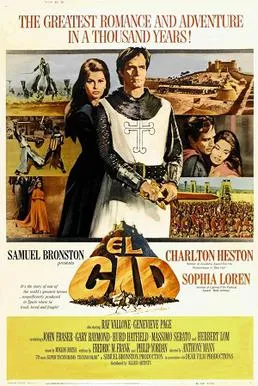Historical accuracy of El Cid

Historical accuracy of El Cid

Characters
Rodrigo Díaz de Vivar ("El Cid")
Based on the real historical figure, but heavily idealized. The film highlights his honor and quest for Christian unity, downplaying his pragmatic alliances (including with Muslims) and personal ambition.
Jimena Díaz (Chimène)
She was Rodrigo's historical wife. However, the central conflict (Rodrigo killing her father, her demanding vengeance) is based on later legends (Mocedades de Rodrigo), not contemporary history.
Count Gormaz (Jimena's Father)
This character and his death at Rodrigo's hands are derived from legend, not historical records. Jimena's actual father was Diego Fernández, Count of Oviedo.
King Ferdinand I
Based on the historical King Ferdinand I of León and Castile. His portrayal as a concerned ruler dividing his kingdom is broadly consistent with history, though simplified.
Prince/King Sancho II
Based on the historical King Sancho II of Castile. The film depicts his ambition and Rodrigo's service to him, which is historically accurate.
Prince/King Alfonso VI
Based on King Alfonso VI of León and Castile. While historically complex, the film portrays him mainly as jealous and suspicious of Rodrigo, simplifying the political reasons for their conflicts and Rodrigo's exile.
More characters
Infanta Urraca
Based on the historical Infanta Urraca of Zamora. While influential, the film invents her romantic obsession with Rodrigo and heavily implies involvement in Sancho's death, lacking historical evidence.
Ben Yusuf
Represents Yusuf ibn Tashfin, leader of the Almoravids. The film portrays him as the main antagonist aiming to conquer Spain; historically, he intervened in Iberia but the portrayal simplifies his role and motivations.
Al-Mu'tamin
Based on Al-Mu'tamin ibn Hud, the historical Muslim ruler of Zaragoza whom Rodrigo served during his exile. Their relationship of mutual respect in the film is plausible.
Count Ordoñez
Likely a composite character or based loosely on García Ordóñez, a historical rival of Rodrigo. Serves as a dramatic foil representing courtly opposition to El Cid.
Babieca
El Cid's horse, Babieca, is historically documented and famous in legend.
Story
Rodrigo spares captured Moorish emirs
This early act establishing Rodrigo's honor is likely fictional, designed for character development rather than based on a specific historical event.
Rodrigo kills Jimena's father in a duel
This key plot point is taken from later legends (Mocedades de Rodrigo) and is not historically accurate.
Rodrigo wins Calahorra in a judicial duel
Rodrigo Díaz de Vivar did historically fight and win a trial by combat for the possession of the city of Calahorra on behalf of King Sancho II.
Rodrigo serves King Sancho II loyally
Rodrigo was a prominent military commander (alférez) under King Sancho II of Castile before the king's death.
Assassination of King Sancho II at Zamora
King Sancho II was assassinated while besieging the city of Zamora, held by his sister Urraca. The exact circumstances and conspirators remain historically uncertain.
Rodrigo forces Alfonso VI to swear an oath
The film depicts the legendary Oath of Santa Gadea, where Rodrigo allegedly forced Alfonso to swear innocence in Sancho's death. This event is prominent in epics but not confirmed by contemporary sources.
Rodrigo's exile by King Alfonso VI
Alfonso VI did exile Rodrigo multiple times. The film emphasizes personal jealousy, while historical reasons were likely more complex, involving politics and Rodrigo's independent actions.
Rodrigo serves the Muslim Emir of Zaragoza
During his first exile (c. 1081-1086), Rodrigo entered the service of Al-Mu'tamin, the Muslim ruler of the Taifa of Zaragoza, fighting for him against various enemies.
Rodrigo conquers the city of Valencia
Acting independently, Rodrigo besieged and captured the city of Valencia from its Almoravid-aligned ruler in 1094, establishing his own principality.
Rodrigo defends Valencia against Ben Yusuf
Rodrigo defended Valencia against Almoravid forces. However, Ben Yusuf (Yusuf ibn Tashfin) himself rarely led campaigns deep into Iberia; the attacks were usually led by his commanders.
Dead Cid leads final charge strapped to horse
This iconic scene is pure legend from later epic poems. Rodrigo died in Valencia in 1099; his wife Jimena held the city for a few years before the Almoravids eventually took it.
Portrayal of Christian vs. Muslim conflict
The film presents a simplified struggle between unified Christians and invading Moors. Historically, alliances frequently shifted, with Christians fighting Christians and Muslims fighting Muslims, and Rodrigo himself allied with Muslim rulers.
Rodrigo's unwavering focus on Spanish unity
While Rodrigo became a symbol of Spanish identity later, his historical actions were often driven by personal ambition, honor, and survival within the complex politics of 11th-century Iberia.
Setting
Filming locations in Spain
The use of actual Spanish landscapes and castles (like Ampudia, Belmonte, Peñíscola) lends authenticity to the setting, even if specific castles don't always match historical locations.
Costumes and Armor
Typical of Hollywood epics of the era, costumes and armor are often inaccurate, overly elaborate, or mix elements from different periods (e.g., later plate armor) for visual spectacle.
Castle architecture depiction (e.g., Valencia)
While visually impressive, the castles sometimes reflect later periods or are composite designs. Peñíscola castle, used for Valencia, looks significantly different from 11th-century Valencia.
Large scale battle scenes
The battles are spectacular but prioritize cinematic action over accurate 11th-century tactics, formations, and siege warfare techniques.
General atmosphere of 11th Century Iberia
Captures an epic, romanticized vision of the era but simplifies the complex political and cultural landscape of the Reconquista and the interactions between Christian kingdoms and Muslim taifas.
Depiction of Royal court life and politics
Shows elements of medieval court life but dramatizes intrigue and motivations heavily, particularly concerning Alfonso VI and Urraca.
Representation of Almoravid forces
Depicted as a powerful invading force, but visually represented often generically 'Moorish' without specific attention to distinct Almoravid Berber military equipment or appearance.
